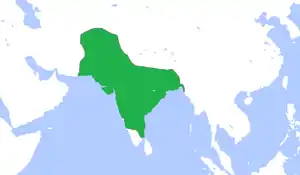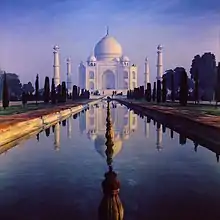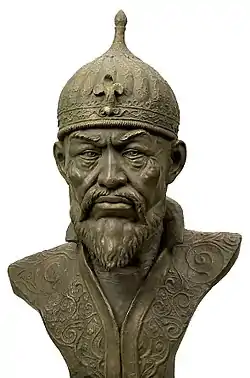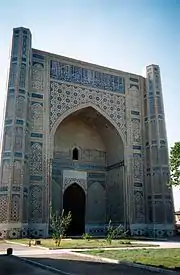امپراتوری گورکانی
امپراتوری مغول هند یا گورکانیان هندوستان یک امپراتوری پارسیمآب و پارسی زبان با سنت ترکی-مغولی[1][2][3][4][5][6][7][8] و مسلمان با فرهنگی ایرانی[2][3] در شبهقاره هند بود.[5] این دولت که برای بیش از سه سده بر مناطق وسیعی در جنوب آسیا فرمان راند، در سال ۱۵۲۶ میلادی توسط بابر بنیان گذاشته شد.
امپراتوری گورکانی/مغولی هند | |||||||||||||||||||||||||||||||
|---|---|---|---|---|---|---|---|---|---|---|---|---|---|---|---|---|---|---|---|---|---|---|---|---|---|---|---|---|---|---|---|
| ۱۵۲۶–۱۸۵۸ | |||||||||||||||||||||||||||||||
 پرچم | |||||||||||||||||||||||||||||||
 پهناوری امپراتوری مغولی/گورکانی هند | |||||||||||||||||||||||||||||||
| پایتخت | آگرا (۱۵۲۶–۱۵۴۰; ۱۵۵۵–۱۵۷۱; ۱۵۹۸–۱۶۴۸) | ||||||||||||||||||||||||||||||
| پایتخت در تبعید | فاتحپور سیکری(۱۵۷۱–۱۵۸۵)
لاهور (مه ۱۵۸۶ – ۱۵۹۸) دهلی(۱۶۴۸–۱۸۵۷) | ||||||||||||||||||||||||||||||
| زبان(های) رایج | فارسی (زبان رسمی و درباری) ترکی جغتایی (زبان مادری در ابتدای سلسله) اردو (زبان مادری در انتهای سلسله) | ||||||||||||||||||||||||||||||
| دین(ها) | اسلام | ||||||||||||||||||||||||||||||
| حکومت | امپراتوری | ||||||||||||||||||||||||||||||
• ۱۵۲۶–۱۵۳۰ | ظهیرالدین محمد (نخستین) | ||||||||||||||||||||||||||||||
• ۱۸۳۷–۱۸۵۷ | میرزا ابوظفر سراجالدین محمد (واپسین) | ||||||||||||||||||||||||||||||
| تاریخ | |||||||||||||||||||||||||||||||
• بنیانگذاری | ۱۵۲۶ | ||||||||||||||||||||||||||||||
• فروپاشی | ۱۸۵۸ | ||||||||||||||||||||||||||||||
| |||||||||||||||||||||||||||||||
بابر، یکی از شاهزادگان تیموری، با پشتیبانی ایران و عثمانی در جهت تضعیف سلطان دهلی، ابراهیم لودی، به جنوب آسیا لشکر کشید[9] و در نبرد نخست پانیپت دولت دهلی را به سختی شکست داد و بر شمال هند مسلط شد. با این حال، ظهور گورکانیان بهعنوان یک قدرت منطقهای، حدوداً در سال ۱۶۰۰ میلادی و در دوران اکبر، نوهٔ بابر، روی داد.[10] امپراتوری وسیع اکبر تا پایان حکومت اورنگزیب، آخرین پادشاه بزرگ گورکانی، پا بر جا ماند[11][12] و پس از مرگ او در ۱۷۰۷ میلادی، زوال آنان آغاز شد. گورکانیان در سال ۱۷۳۹ میلادی به سختی از نادرشاه، شاه ایران، در نبرد کرنال شکست خوردند که این مسئله عملاً زمینهساز سقوط نهایی آنان شد و سرانجام رفته رفته تمام قلمروی گورکانیان توسط کمپانی هند شرقی تصرف گردید. پس از شورش ۱۸۵۷، امپراتوری بریتانیا رسماً دولت تیموری را منحل کرد و حکومت شبهقاره به راج بریتانیا واگذار شد.
گرچه امپراتوری مغولی هند با لشکرکشیهای متعدد نظامی تأسیس شد و پابرجا ماند،[13][14][15] اما فرمانروایان گورکانی تلاشی برای سرکوب فرهنگها و ادیان محلی نکردند و با تقسیمبندی امپراتوری به مناطق پرشمار اداری[16][17] و با وجود طبقه حاکمی که از فرهنگها و ادیان مختلف تشکیل شده بود، یک دولت کارآمدتر و متمرکزتر در این دوران بر هندوستان فرمان راند.[18] صلح نسبیای که در دوران تیموریان بر شبهقاره حکم فرما بود، منجر به این گردید که در سدهٔ هفدهم میلادی، اقتصاد هند با گسترش چشمگیری روبرو شود.[19] از دیگر دلایل مهم در توسعهٔ اقتصادی دولت مغول، اصلاحات اکبر در سیستم مالیاتِ محصول کشاورزی بود.[20][21] همچنین در دوران اوج گورکانیان، هند سهمی ۲۵ درصدی از تولیدات جهان را در اختیار داشت[22] که همین مسئله یکی از دلایل افزایش حضور اروپاییها در این منطقه بود.[23]
شیوهٔ زندگی پرخرج حکام گورکانی هند،[24] بهخصوص در زمان شاه جهان، منجر به پشتیبانی آنان از هنرهایی نظیر نگارگری و معماری گردید[25] و در همین رابطه، آثار هنری پرشماری از دورهٔ گورکانی امروزه در کشورهای هند، پاکستان، افغانستان و بنگلادش بر جای ماندهاست. قلعه آگره، فاتح پور سیکری، لال قلعه، آرامگاه همایون، قلعه شاهی و تاج محل از جمله آثار گورکانی به جا مانده در سرزمینهای تحت فرمان آنان هستند که در فهرست میراث جهانی یونسکو قرار دارند.[26]
تاریخچه
پس از مرگ تیمور، ترکان عثمانی و آل جلایر و ترکمانان قراقویونلو، برخی سرزمینهایی را که تیمور گرفته بود تصرف کردند. با این همه، فرزندان تیمور موفق شدند که شمال ایران را در مدت یک سده تحت فرمانروایی خود نگاهدارند؛ ولی آنان اغلب با یکدیگر در کشمکش بودند. سرانجام شاهرخ موفق شد که مناقشات اقوام خود را تا حدی رفع و قدرت و اعتبار کشور را نگهداری کند؛ ولی پس از مرگ او منطقه تحت فرمانش به قسمتهای کوچکتر مجزا شد و صفویان توانستند آنها را به حکومت خود پیوست کنند.
با این حال خاندان تیموری از میان نرفت و نوادگان تیمور به سرکردگی بابر چندی پستر فرمانروایی خود را به هندوستان بردند و دولت سلسلهٔ بابری را بنیاد گذاردند که اروپائیان آن را مغول کبیر مینامند.
دوران شکوه امپراتوری گورکانی یا مغول کبیر تا اواسط پادشاهی اورنگزیب عالمگیر بود پس از وی یعنی در دوران مغول صغیر از قدرت این امپراتوری به شدت کاسته شد و کشور هند که در روزگار اکبرشاه و شاهجهان و اورنگزیب سیر تمدن و ترقی را آغاز کرده بود رو به ضعف نهاد. بهادرشاه دوم آخرین فرمانروای گورکانی بود که در سال ۱۸۵۷ میلادی تاج و تخت را به انگلیسیها واگذار کرد.
پس از حملهٔ نادرشاه گورکانیان ضعیف شدند در جنوب پادشاهی ماراتا که قدرتی تازه و دشمنی خطرناک از هر لحاظ حتی فرهنگی بهشمار میآمد مناطق جنوبی را تصرف کرد. دین رسمی حکومت ماراتا هندو بود در حالی که گورکانیان یک دولت مسلمان بودند. به این ترتیب گورکانیان ضعیف شدند تا اینکه در سال ۱۸۵۷ میلادی بدست کمپانی هند شرقی بریتانیا نابود شدند.
پادشاهان گورکانی هندوستان

| پادشاهان گورکانی هندوستان | ||||||||||||
| پادشاه | آغاز پادشاهی | پایان پادشاهی | نسبت خانوادگی | |||||||||
|---|---|---|---|---|---|---|---|---|---|---|---|---|
| بابر | ۱۵۲۶ | ۱۵۳۰ | مؤسس دودمان
(پسر عمرشیخدوم/نوه ابوسعید) | |||||||||
| همایون | ۱۵۳۰ | ۱۵۵۶ | پسر بابر | |||||||||
| اکبر | ۱۵۵۶ | ۱۶۰۵ | پسر همایون | |||||||||
| جهانگیر | ۱۶۰۵ | ۱۶۲۷ | پسر اکبر | |||||||||
| شاه جهان | ۱۶۲۷ | ۱۶۵۸ | پسر جهانگیر | |||||||||
| اورنگزیب | ۱۶۵۸ | ۱۷۰۷ | پسر شاهجهان | |||||||||
| بهادرشاه یکم | ۱۷۰۷ | ۱۷۱۲ | پسر اورنگزیب | |||||||||
| جهاندار شاه | ۱۷۱۲ | ۱۷۱۳ | پسر بهادرشاه یکم | |||||||||
| فرخسیر شاه | ۱۷۱۹ | ۱۷۱۹ | نوه بهادرشاه یکم
(پسر عظیمالشأن میرزا) | |||||||||
| رفیع الدرجات | ۱۷۱۹ | ۱۷۱۹ | نوه بهادرشاه یکم
(پسر رفیعالشأن میرزا) | |||||||||
| رفیع الدولت | ۱۷۱۹ | ۱۷۱۹ | نوه بهادرشاه یکم
(پسر رفیعالشأن میرزا) | |||||||||
| محمدشاه | ۱۷۱۹ | ۱۷۴۸ | نوه بهادرشاه یکم
(پسر جهان شاه) | |||||||||
| احمدشاه بهادر | ۱۷۴۸ | ۱۷۵۴ | پسر محمدشاه | |||||||||
| عالمگیر دوم | ۱۷۵۴ | ۱۷۵۹ | پسر جهاندار شاه | |||||||||
| شاهجهان سوم | ۱۷۵۹ | ۱۷۵۹ | نتیجه اورنگزیب
(پسر محیالسنت) | |||||||||
| شاه عالم دوم | ۱۷۵۹ | ۱۸۰۶ | پسر عالمگیر دوم | |||||||||
| اکبر دوم | ۱۸۰۶ | ۱۸۳۷ | پسر شاه عالم دوم | |||||||||
| بهادرشاه دوم | ۱۸۳۷ | ۱۸۵۷ | پسر اکبر دوم | |||||||||
زبان فارسی
در زمان گورکانیان هند زبان فارسی در این کشور گسترش پیدا کرد. اگر چه پیش از به قدرت رسیدن این خاندان در هند، دین اسلام توسط عرفای فارسیزبان در شبه قاره هند نفوذ کرده بود، اما تأثیر ظهور این خاندان در هندوستان، گسترش و رونق زبان فارسی را به حدی رسانید که ادبیات فارسی نه تنها مایه حیات روحی مردم عام شد بلکه این زبان، زبان رسمی درباریان نیز گردید. این رویکرد باعث هجرت بسیاری از هنرمندان، نویسندگان و شاعران از ایران به هند شد.[27] دوران طلایی ادب فارسی در هند، دورهٔ اکبر کبیر است. به امر وی وزیرش تودارمال فرمانی را صادر کرد که به موجب آن، زبان فارسیزبان تمام امپراتوری اعلام گردید. همچنین به فرمان اکبر شاه برخی از کتابهای مهم هندوان از سانسکریت به نظم و نثر فارسی ترجمه شد و بر غنای ادب فارسی افزوده گردید. اگر در دورهٔ غزنویان مرکز زبان فارسی در هند تنها شهر لاهور بود، این مرکزیت در سدههای بعدی به ترتیب به مولتان و دهلی و اگره منتقل گردید. علاوه بر شاعران و عالمان و نویسندگان ایرانی که در مدت چند سده به هند مهاجرت کردند، از هندیان اعم از مسلمان و هندو، شاعران و نویسندگان و عالمان بزرگی ظهور کردند که آثارشان به فارسی است. دوران فرمانروایی گورکانیان هند با دورهٔ فرمانروایی دودمان صفوی در ایران همزمان است که این خود به گونهای ناخواسته یکی از عوامل مؤثر در نیرو گرفتن زبان پارسی در هند بهشمار میرود. نوع نگاه پادشاهان صفوی به ادبیات و فرهنگ به گونهای بود که شاعران و نویسندگان ایران را از بخشش و نواخت پادشاهان صفوی ناامید میکرد و آنان گاه ناگزیر و گاه مشتاقانه رهسپار دربار ادبپرور گورکانی میشدند.[28]
تبارنامه
منابع
- "Mughal dynasty | History, Map, Rulers, & Facts". Encyclopedia Britannica. Retrieved 2020-05-29.
- B.F. Manz, "Tīmūr Lang", in Encyclopaedia of Islam, Online Edition, 2006
- Maria Subtelny, Timurids in Transition, 40: "Nevertheless, in the complex process of transition, members of the Timurid dynasty and their Persian Mongol supporters became acculturate by the surrounding Persianate millieu adopting Persian cultural models and tastes and acting as patrons of Persian culture, painting, architecture and music." pg 41: "The last members of the dynasty, notably Sultan-Abu Sa'id and Sultan-Husain, in fact came to be regarded as ideal Perso-Islamic rulers who develoted as much attention to agricultural development as they did to fostering Persianate court culture." Jump up ^
- "Timur | Biography, Conquests, Empire, & Facts". Encyclopedia Britannica. Retrieved 2020-05-29.
- Richards, John F. (1995), The Mughal Empire, Cambridge University Press, p. 2, ISBN 978-0-521-56603-2 Quote: "Although the first two Timurid emperors and many of their noblemen were recent migrants to the subcontinent, the dynasty and the empire itself became indisputably Indian. The interests and futures of all concerned were in India, not in ancestral homelands in the Middle East or Central Asia. Furthermore, the Mughal Empire emerged from the Indian historical experience. It was the end product of a millennium of Muslim conquest, colonization, and state-building in the Indian subcontinent."
- Josef W. Meri (2005). Medieval Islamic Civilization. Routledge. p. 812. ISBN 978-0-415-96690-0.
- "Indo-Persian Literature Conference: SOAS: North Indian Literary Culture (1450-1650)". www.soas.ac.uk. Retrieved 2021-01-26.
- Soucek, Svat (2000/02). "Timur and the Timurids". A History of Inner Asia. p. Timur was born around 1336 in Transoxania near Kesh – later known as Shahrisabz – in the Kashka Darya region of what is today the Republic of Uzbekistan. He was a Turk of the Barlas tribe; this tribe, like many others, boasted a Mongol name and ancestry, but for all practical purposes it was Turkic. Retrieved 2021-02-05. Check date values in:
|تاریخ=(help) - Gilbert, Marc Jason (2017), South Asia in World History, Oxford University Press, pp. 75–, ISBN 978-0-19-066137-3 Quote: "Babur then adroitly gave the Ottomans his promise not to attack them in return for their military aid, which he received in the form of the newest of battlefield inventions, the matchlock gun and cast cannons, as well as instructors to train his men to use them."
- Stein, Burton (2010), A History of India, John Wiley & Sons, pp. 159–, ISBN 978-1-4443-2351-1 Quote: "Another possible date for the beginning of the Mughal regime is 1600, when the institutions that defined the regime were set firmly in place and when the heartland of the empire was defined; both of these were the accomplishment of Babur’s grandson Akbar."
- Stein, Burton (2010), A History of India, John Wiley & Sons, pp. 159–, ISBN 978-1-4443-2351-1 Quote: "The imperial career of the Mughal house is conventionally reckoned to have ended in 1707 when the emperor Aurangzeb, a fifth-generation descendant of Babur, died. His fifty-year reign began in 1658 with the Mughal state seeming as strong as ever or even stronger. But in Aurangzeb’s later years the state was brought to the brink of destruction, over which it toppled within a decade and a half after his death; by 1720 imperial Mughal rule was largely finished and an epoch of two imperial centuries had closed."
- Richards, John F. (1995), The Mughal Empire, Cambridge University Press, p. xv, ISBN 978-0-521-56603-2 Quote: "By the latter date (1720) the essential structure of the centralized state was disintegrated beyond repair."
- Stein, Burton (2010), A History of India, John Wiley & Sons, pp. 159–, ISBN 978-1-4443-2351-1 Quote: "The vaunting of such progenitors pointed up the central character of the Mughal regime as a warrior state: it was born in war and it was sustained by war until the eighteenth century, when warfare destroyed it."
- Robb, Peter (2011), A History of India, Macmillan, pp. 108–, ISBN 978-0-230-34549-2 Quote: "The Mughal state was geared for war, and succeeded while it won its battles. It controlled territory partly through its network of strongholds, from its fortified capitals in Agra, Delhi or Lahore, which defined its heartlands, to the converted and expanded forts of Rajasthan and the Deccan. The emperors' will was frequently enforced in battle. Hundreds of army scouts were an important source of information. But the empire's administrative structure too was defined by and directed at war. Local military checkpoints or thanas kept order. Directly appointed imperial military and civil commanders (faujdars) controlled the cavalry and infantry, or the administration, in each region. The peasantry in turn were often armed, able to provide supporters for regional powers, and liable to rebellion on their own account: continual pacification was required of the rulers."
- Gilbert, Marc Jason (2017), South Asia in World History, Oxford University Press, pp. 75–, ISBN 978-0-19-066137-3 Quote: "With Safavid and Ottoman aid, the Mughals would soon join these two powers in a triumvirate of warrior-driven, expansionist, and both militarily and bureaucratically efficient early modern states, now often called "gunpowder empires" due to their common proficiency is using such weapons to conquer lands they sought to control."
- Asher, Catherine B.; Talbot, Cynthia (2006), India Before Europe, Cambridge University Press, pp. 115–, ISBN 978-0-521-80904-7
- Robb, Peter (2011), A History of India, Macmillan, pp. 99–100, ISBN 978-0-230-34549-2
- Asher, Catherine B.; Talbot, Cynthia (2006), India Before Europe, Cambridge University Press, pp. 152–, ISBN 978-0-521-80904-7
- Asher, Catherine B.; Talbot, Cynthia (2006), India Before Europe, Cambridge University Press, pp. 152–, ISBN 978-0-521-80904-7 Quote: "Above all, the long period of relative peace ushered in by Akbar's power, and maintained by his successors, contributed to India's economic expansion."
- Stein, Burton (2010), A History of India, John Wiley & Sons, pp. 164–, ISBN 978-1-4443-2351-1 Quote: "The resource base of Akbar’s new order was land revenue"
- Asher, Catherine B.; Talbot, Cynthia (2006), India Before Europe, Cambridge University Press, pp. 158–, ISBN 978-0-521-80904-7 Quote: "The Mughal empire was based in the interior of a large land-mass and derived the vast majority of its revenues from agriculture."
- Jeffrey G. Williamson & David Clingingsmith, India's Deindustrialization in the 18th and 19th Centuries, Global Economic History Network, London School of Economics
- Asher, Catherine B.; Talbot, Cynthia (2006), India Before Europe, Cambridge University Press, pp. 186–, ISBN 978-0-521-80904-7 Quote: "As the European presence in India grew, their demands for Indian goods and trading rights increased, thus bringing even greater wealth to the already flush Indian courts."
- Asher, Catherine B.; Talbot, Cynthia (2006), India Before Europe, Cambridge University Press, pp. 186–, ISBN 978-0-521-80904-7 Quote: "The elite spent more and more money on luxury goods, and sumptuous lifestyles, and the rulers built entire new capital cities at times."
- Asher, Catherine B.; Talbot, Cynthia (2006), India Before Europe, Cambridge University Press, pp. 186–, ISBN 978-0-521-80904-7 Quote: "All these factors resulted in greater patronage of the arts, including textiles, paintings, architecture, jewelry, and weapons to meet the ceremonial requirements of kings and princes."
- Taj Mahal: UNESCO World Heritage Center
- ملا احمد تتوی، آصف خان قزوینی (۱۳۸۲). تاریخ الفی. اول. تهران: شرکت انتشارات علمی فرهنگی. ص. ۱. شابک ۹۶۴۴۴۵۲۷۳۹.
- کورش جنتی (۷ آذر ۱۳۹۳). «پیوند زبانی و فرهنگی ایران و هند». بایگانیشده از اصلی در ۱۱ فوریه ۲۰۱۵. دریافتشده در ۲۳ بهمن ۱۳۹۳.
پیوند به بیرون
| در ویکیانبار پروندههایی دربارهٔ امپراتوری گورکانی موجود است. |
https://web.archive.org/web/20161012234923/http://tarikh1.com/mughal-dynasty/


